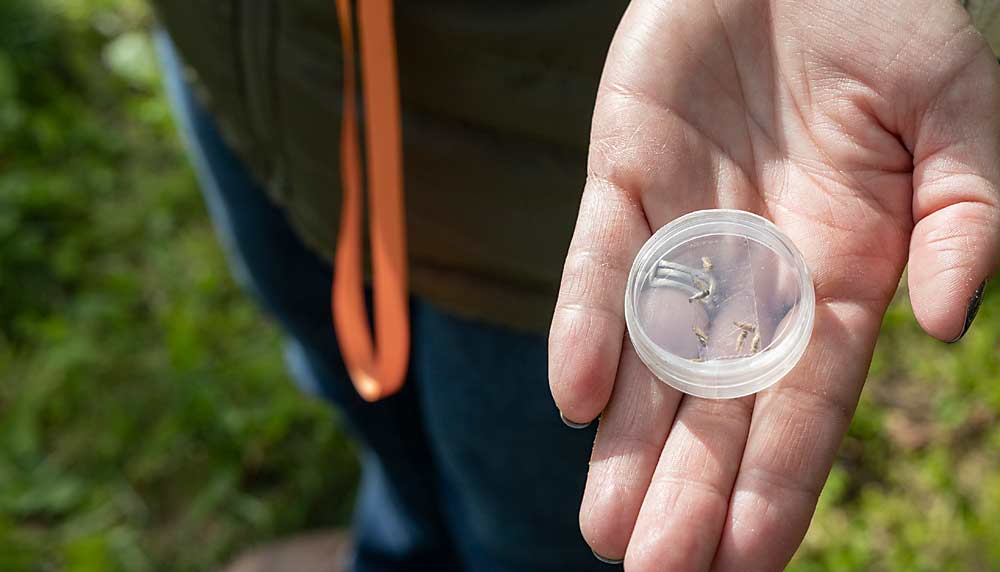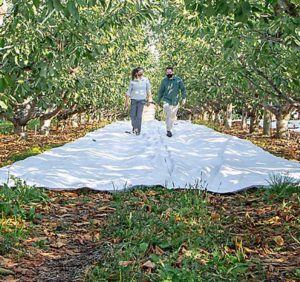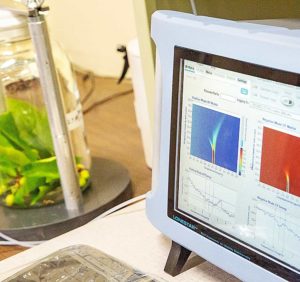
The leafhoppers that transmit X disease don’t just feed on cherry trees. In fact, they seem to prefer broadleaf weeds common on the orchard floor — a finding that suggests new control strategies and new research directions.
From sticky-card traps to DNA analysis of leafhoppers’ gut contents, scientists have accumulated a pile of evidence indicating groundcover plays a key part of the X disease equation. X disease — often referred to under the umbrella term “little cherry disease” and which results in small, bitter, poorly colored and unmarketable stone fruit — is forcing orchardists to remove trees across the state. Now, the question is what growers can do with the new information about weeds to reduce the risk of disease in their orchards.
In the past two years, Washington State University entomologist Tobin Northfield and his research team have demonstrated that covering the orchard floor with reflective mulch reduces leafhopper trap catch by 80 to 90 percent, depending on the site.
“Now that we know removing the groundcover is so impactful, can we just remove the broadleaf weeds with herbicides?” Northfield said in explaining the research project he’ll start this season.
The team also determined the leafhoppers’ favorite hosts include dandelion, mallow, alfalfa and clover. Those perennials can be a source of the X phytoplasma from one year to the next.
And increasingly more of the phytoplasma pathogen that causes X disease has been found in those weeds, according to WSU pathologist Scott Harper. In 2018, his lab tested common orchard weeds, and only four out of 1,000 tested positive. Last year, his team found almost 20 percent of the 500 weeds they tested were positive.
“There’s just a lot more phytoplasma running around now than in 2018,” he said.
That’s not to say the X disease is necessarily coming from the weeds. Harper said the high rates of weeds testing positive correlates with orchards where high rates of trees are positive. And while a dandelion might test positive with one or two phytoplasma cells in its tissue sample, cherry tree samples can contain 10,000 or 100,000 phytoplasma cells.
So, where is a leafhopper more likely to pick up the phytoplasma while feeding? Harper likens feeding on an infected tree to fishing in a river flush with fish, while the dandelion is a river with just a few fish.
“If there are thousands of fish swimming down a river and you put your net out, you are going to catch one,” he said. Translation: Weeds matter, but removing infected trees remains the top priority.
Understanding X disease dynamics
The more phytoplasma in host plants, the greater the risk that any given leafhopper could transmit it. But it’s not that simple. After the insect feeds on infected plants, the phytoplasma must move from the insect’s gut into the hemolymph — the insect equivalent of blood — and then into the salivary glands. That process takes time, giving growers a window to kill the leafhoppers before they become vectors.
New research projects launching this year, funded by the Washington Tree Fruit Research Commission and Oregon Sweet Cherry Commission, will look at the insects’ phenology, to understand the best time to target sprays and to learn more about the juvenile life stages and how they disperse and travel in the orchard and extraorchard environment.
Learning more about the juveniles, which seem to spend a lot of time in the ground cover, could be especially important, Northfield said, as “it’s unlikely they are surviving as adults in commercial orchards for a month.”
Research done decades ago found that it took about 30 days from feeding on an infected plant to transmitting the phytoplasma. Scientists want to revisit the question with modern, molecular analysis tools — and Northfield is trying to establish a lab colony for such trials.
Right now, Harper’s lab tests wild-caught leafhoppers. First, they separate the heads from the bodies, to distinguish between phytoplasma in the salivary gland versus the gut. Only between 5 and 10 percent of the head samples last season tested positive, meaning they were able to transmit the phytoplasma, Harper said.
“The guts are at least twice that. There are more feeding on it than have become vectors, or might have become vectors if we hadn’t cut their heads off,” Harper said.
Meanwhile, collaborators at the U.S. Department of Agriculture’s Agricultural Research Service lab in Wapato are most interested in the leafhopper’s body. Entomologist and research leader Rodney Cooper developed a technique to examine DNA in the gut content to determine the insects’ feed sources.
All of this information together helps researchers to better understand leafhoppers’ patterns of behavior, Harper said, and, consequently, the landscape of X disease: Where did it originate, why is it worse in some places than others, where is it going next?
Already, that work has uncovered something intriguing.
“What we’ve found is that there are at least three different variants of the X disease phytoplasma,” Harper said. One is generally found in other regions, and was perhaps found in Washington in the past, but today’s outbreak is driven by two different variants. “The data suggests that it’s not the same pathogen it was” during previous outbreaks decades ago.
Whether that means this outbreak is proving to be more severe or transmissible is one focus of his research. (Harper’s lab group is also looking at how the phytoplasma causes disease in stone fruit trees by interrupting normal fruit development.)
Weed control for disease control
Northfield will launch research this year to understand if and how herbicides can help growers reduce leafhopper populations in their orchards, funded with a Specialty Crop Block Grant from the state. Taking broadleaf weed management from just the tree rows to the entire drive row may pose a big challenge, he said.
For cherry growers who don’t want to wait for research results to try weed control strategies of their own, Matthew Smith from Northwest Wholesale shared strategies at the little cherry disease workshop organized in February by WSU Extension. It’s important to know what weeds you are trying to kill and the type of herbicide you are using, he said.
“To keep it real simple, there’s residuals and contact killers,” he said.
Residual herbicides include preemergents — such as Prowl (pendimethalin) and Soilcam (norflurazon) — that prevent seeds from germinating, and noncontact herbicides — such as Alion (indaziflam), Matrix (rimsulfuron) and Pindar (penoxsulam plus oxyfluorfen) — that are absorbed by the weed roots over time.
Contact herbicides include Roundup (glyphosate), which he doesn’t recommend around young trees, Gramoxone (paraquat), which has become more difficult to use with new regulations, and products that target broadleaf weeds, such as Stinger (clopyralid), Rely (glufosinate) and Venue (pyraflufen-ethyl).
“Venue will leave behind clover. So, you may need an alternative herbicide to target the weeds you have in your orchard,” he said.
He advises against 2,4-D (2,4-dichlorophenoxyacetic acid) in cherry blocks, as it can be picked up by the tree roots, and he said organic growers don’t have great alternatives for weed control. Regular mowing will promote grass growth to compete with broadleaf weeds, he added.
—by Kate Prengaman
WSU diagnostic clinic now offers X disease testing
In April, the Washington State University Plant Pest Diagnostic Clinic in Pullman began offering testing for X phytoplasma and little cherry virus 2, the pathogens responsible for little cherry disease in the Pacific Northwest.
The new testing capacity is supported by a $530,000 grant from the Washington State Department of Agriculture’s Specialty Crop Block Grant Program, received by the Washington State Tree Fruit Association to support the cherry industry’s need for testing.
The goal of the grant is to lower the cost of testing to $50 per test, to make it more affordable for growers to identify trees that need to be removed. Testing was initially offered at the Clean Plant Center Northwest, housed at WSU’s Prosser campus, but demand soon exceeded capacity. Commercial labs began offering tests in 2020, but such services can be costly.
“Affordable and available testing is a key element of our industry’s response to little cherry disease” said Jon DeVaney, WSTFA president, in a WSU news release.
For more information about WSU’s diagnostic clinic, go to: plantpath.wsu.edu/diagnostics. A full list of labs with little cherry disease testing capacity is available at: treefruit.wsu.edu/labs-lchv2-xdp.
—K. Prengaman








Leave A Comment